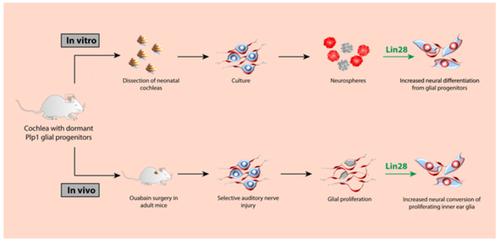当前位置:
X-MOL 学术
›
STEM CELLS
›
论文详情
Our official English website, www.x-mol.net, welcomes your feedback! (Note: you will need to create a separate account there.)
Lin28 reprograms inner ear glia to a neuronal fate
STEM CELLS ( IF 5.2 ) Pub Date : 2020-04-30 , DOI: 10.1002/stem.3181 Judith S Kempfle 1, 2, 3 , Ngoc-Nhi C Luu 1, 2, 4 , Marco Petrillo 1, 2 , Reef Al-Asad 1, 2 , Andrea Zhang 1, 2 , Albert S B Edge 1, 2, 5, 6
STEM CELLS ( IF 5.2 ) Pub Date : 2020-04-30 , DOI: 10.1002/stem.3181 Judith S Kempfle 1, 2, 3 , Ngoc-Nhi C Luu 1, 2, 4 , Marco Petrillo 1, 2 , Reef Al-Asad 1, 2 , Andrea Zhang 1, 2 , Albert S B Edge 1, 2, 5, 6
Affiliation

|
Sensorineural hearing loss is irreversible and can be caused by loss of auditory neurons. Regeneration of neural cells from endogenous cells may offer a future tool to restore the auditory circuit and to enhance the performance of implantable hearing devices. Neurons and glial cells in the peripheral nervous system are closely related and originate from a common progenitor. Prior work in our lab indicated that in the early postnatal mouse inner ear, proteolipid protein 1 (Plp1) expressing glial cells could act as progenitor cells for neurons in vitro. Here, we used a transgenic mouse model to transiently overexpress Lin28, a neural stem cell regulator, in Plp1‐positive glial cells. Lin28 promoted proliferation and conversion of auditory glial cells into neurons in vitro. To study the effects of Lin28 on endogenous glial cells after loss of auditory neurons in vivo, we produced a model of auditory neuropathy by selectively damaging auditory neurons with ouabain. After neural damage was confirmed by the auditory brainstem response, we briefly upregulated the Lin28 in Plp1‐expressing inner ear glial cells. One month later, we analyzed the cochlea for neural marker expression by quantitative RT‐PCR and immunohistochemistry. We found that transient Lin28 overexpression in Plp1‐expressing glial cells induced expression of neural stem cell markers and subsequent conversion into neurons. This suggests the potential for inner ear glia to be converted into neurons as a regeneration therapy for neural replacement in auditory neuropathy.
中文翻译:

Lin28 将内耳胶质细胞重新编程为神经元命运
感音神经性听力损失是不可逆的,可能是由听觉神经元的损失引起的。从内源性细胞再生神经细胞可能会提供一种未来的工具来恢复听觉回路并提高植入式听力设备的性能。周围神经系统中的神经元和神经胶质细胞密切相关,并且起源于一个共同的祖细胞。我们实验室先前的工作表明,在出生后早期的小鼠内耳中,表达蛋白脂质蛋白 1 (Plp1) 的神经胶质细胞可以在体外充当神经元的祖细胞。在这里,我们使用转基因小鼠模型在 Plp1 阳性神经胶质细胞中瞬时过表达神经干细胞调节剂 Lin28。Lin28 在体外促进听觉神经胶质细胞增殖和转化为神经元。为了研究 Lin28 在体内听觉神经元丧失后对内源性神经胶质细胞的影响,我们通过用哇巴因选择性地破坏听觉神经元来制作听觉神经病变模型。在通过听觉脑干反应确认神经损伤后,我们短暂上调了表达 Plp1 的内耳神经胶质细胞中的 Lin28。一个月后,我们通过定量 RT-PCR 和免疫组织化学分析了耳蜗的神经标志物表达。我们发现在表达 Plp1 的神经胶质细胞中瞬时 Lin28 过表达诱导神经干细胞标志物的表达并随后转化为神经元。这表明内耳神经胶质细胞有可能转化为神经元,作为听觉神经病中神经替代的再生疗法。我们通过用哇巴因选择性地破坏听觉神经元来制作听觉神经病模型。在通过听觉脑干反应确认神经损伤后,我们短暂上调了表达 Plp1 的内耳神经胶质细胞中的 Lin28。一个月后,我们通过定量 RT-PCR 和免疫组织化学分析了耳蜗的神经标志物表达。我们发现在表达 Plp1 的神经胶质细胞中瞬时 Lin28 过表达诱导神经干细胞标志物的表达并随后转化为神经元。这表明内耳神经胶质细胞有可能转化为神经元,作为听觉神经病中神经替代的再生疗法。我们通过用哇巴因选择性地破坏听觉神经元来制作听觉神经病模型。在通过听觉脑干反应确认神经损伤后,我们短暂上调了表达 Plp1 的内耳神经胶质细胞中的 Lin28。一个月后,我们通过定量 RT-PCR 和免疫组织化学分析了耳蜗的神经标志物表达。我们发现在表达 Plp1 的神经胶质细胞中瞬时 Lin28 过表达诱导神经干细胞标志物的表达并随后转化为神经元。这表明内耳神经胶质细胞有可能转化为神经元,作为听觉神经病中神经替代的再生疗法。一个月后,我们通过定量 RT-PCR 和免疫组织化学分析了耳蜗的神经标志物表达。我们发现在表达 Plp1 的神经胶质细胞中瞬时 Lin28 过表达诱导神经干细胞标志物的表达并随后转化为神经元。这表明内耳神经胶质细胞有可能转化为神经元,作为听觉神经病中神经替代的再生疗法。一个月后,我们通过定量 RT-PCR 和免疫组织化学分析了耳蜗的神经标志物表达。我们发现在表达 Plp1 的神经胶质细胞中瞬时 Lin28 过表达诱导神经干细胞标志物的表达并随后转化为神经元。这表明内耳神经胶质细胞有可能转化为神经元,作为听觉神经病中神经替代的再生疗法。
更新日期:2020-04-30
中文翻译:

Lin28 将内耳胶质细胞重新编程为神经元命运
感音神经性听力损失是不可逆的,可能是由听觉神经元的损失引起的。从内源性细胞再生神经细胞可能会提供一种未来的工具来恢复听觉回路并提高植入式听力设备的性能。周围神经系统中的神经元和神经胶质细胞密切相关,并且起源于一个共同的祖细胞。我们实验室先前的工作表明,在出生后早期的小鼠内耳中,表达蛋白脂质蛋白 1 (Plp1) 的神经胶质细胞可以在体外充当神经元的祖细胞。在这里,我们使用转基因小鼠模型在 Plp1 阳性神经胶质细胞中瞬时过表达神经干细胞调节剂 Lin28。Lin28 在体外促进听觉神经胶质细胞增殖和转化为神经元。为了研究 Lin28 在体内听觉神经元丧失后对内源性神经胶质细胞的影响,我们通过用哇巴因选择性地破坏听觉神经元来制作听觉神经病变模型。在通过听觉脑干反应确认神经损伤后,我们短暂上调了表达 Plp1 的内耳神经胶质细胞中的 Lin28。一个月后,我们通过定量 RT-PCR 和免疫组织化学分析了耳蜗的神经标志物表达。我们发现在表达 Plp1 的神经胶质细胞中瞬时 Lin28 过表达诱导神经干细胞标志物的表达并随后转化为神经元。这表明内耳神经胶质细胞有可能转化为神经元,作为听觉神经病中神经替代的再生疗法。我们通过用哇巴因选择性地破坏听觉神经元来制作听觉神经病模型。在通过听觉脑干反应确认神经损伤后,我们短暂上调了表达 Plp1 的内耳神经胶质细胞中的 Lin28。一个月后,我们通过定量 RT-PCR 和免疫组织化学分析了耳蜗的神经标志物表达。我们发现在表达 Plp1 的神经胶质细胞中瞬时 Lin28 过表达诱导神经干细胞标志物的表达并随后转化为神经元。这表明内耳神经胶质细胞有可能转化为神经元,作为听觉神经病中神经替代的再生疗法。我们通过用哇巴因选择性地破坏听觉神经元来制作听觉神经病模型。在通过听觉脑干反应确认神经损伤后,我们短暂上调了表达 Plp1 的内耳神经胶质细胞中的 Lin28。一个月后,我们通过定量 RT-PCR 和免疫组织化学分析了耳蜗的神经标志物表达。我们发现在表达 Plp1 的神经胶质细胞中瞬时 Lin28 过表达诱导神经干细胞标志物的表达并随后转化为神经元。这表明内耳神经胶质细胞有可能转化为神经元,作为听觉神经病中神经替代的再生疗法。一个月后,我们通过定量 RT-PCR 和免疫组织化学分析了耳蜗的神经标志物表达。我们发现在表达 Plp1 的神经胶质细胞中瞬时 Lin28 过表达诱导神经干细胞标志物的表达并随后转化为神经元。这表明内耳神经胶质细胞有可能转化为神经元,作为听觉神经病中神经替代的再生疗法。一个月后,我们通过定量 RT-PCR 和免疫组织化学分析了耳蜗的神经标志物表达。我们发现在表达 Plp1 的神经胶质细胞中瞬时 Lin28 过表达诱导神经干细胞标志物的表达并随后转化为神经元。这表明内耳神经胶质细胞有可能转化为神经元,作为听觉神经病中神经替代的再生疗法。


























 京公网安备 11010802027423号
京公网安备 11010802027423号